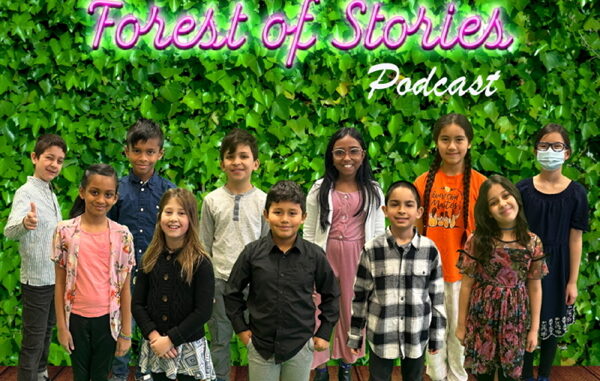
By Mira Campbell
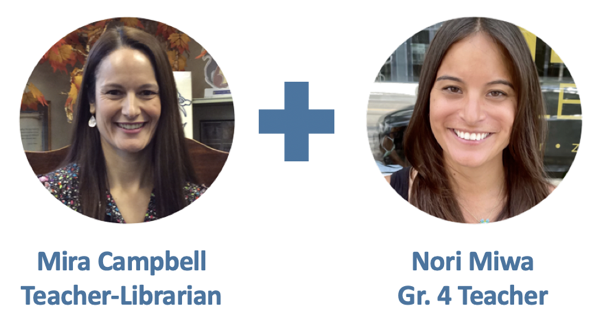
This was a library partnership project with Nori Miwa’s Grade 4 class at FH Miller Jr PS in Toronto, Ontario. It culminated with the library being transformed into the Miller Podcast Café where students were able to relax and enjoy their hard work and celebrate their peers.
The Forest of Reading® is a well known Canadian program which highlights Canadian books and encourages a love of reading. According to their website, more than 270,000 readers participate annually either through their school or public library. Our school signed up to participate for the first time and we were trying to think of an innovative way to promote the nominated books to all the students in the school. We knew we would do read-alouds for all the classes as well as have the whole school participate in the official voting day that takes place in April, but how could we engage all the students and have them connect in a meaningful way with these books?
Nori Miwa is the Grade 4 teacher at FH Miller Jr. PS. We have collaborated on several projects together. We decided this would be a great leadership opportunity for her class and a perfect fit because several of her students are Library Helpers, not to mention avid readers!
Why a Podcast?
Creating media texts not only allows for students to express their creativity, but it allows them to communicate their ideas through a different format while also removing barriers many students face such as writing and/or reluctance to present in front of a class. Podcasts have different styles and formats. We focused on the interview style which fit our project the best.
When we introduced the idea of creating a podcast to the class, they were ecstatic! Later, in their reflection, we learned that some felt like a podcast could only be made by professionals and some were a little nervous because it was new and “we did a lot of things in one day.” They also had no idea the amount of work that goes in behind the scenes to create a podcast. This was a complex project with many components. We will share how we broke it down into manageable sections and supported their learning through Universal Design for Learning Framework and the use of digital tools (e.g., Book Creator and WeVideo).
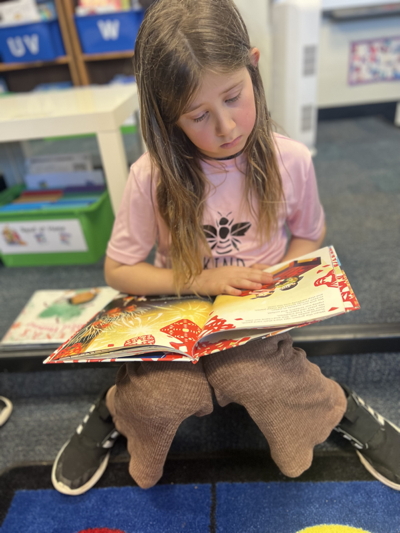
Listening to podcasts is a great way to reach all students by providing an alternative format to access information. We chose the Blue Spruce nominated books as the topic for our podcast because of how they tapped into our students’ interests, identities and lived experiences. Students were given a brief description of each book and then had an opportunity to look through all the nominated books and choose two that captivated them. This was also how we formed the podcast groups. From that initial preview day, they each connected deeply with their chosen book.

What initially drew you to this book, Be a Good Ancestor?
“It shows that the littlest things like a seed becomes something that we need in life like oxygen. This book really stands out because as soon as you go through the second page you realize that it is a repetitive pattern.” ~Xavier, Grade 4
The four chosen books from the Blue Spruce 2023 nominated books were the following: Are you a Cheeseburger? written and illustrated by Monica Arnaldo, Abuelita & Me by Leonarda Carranza and illustrated by Rafael Mayani, Friends are Friends, Forever written by Dane Liu and illustrated by Lynn Scurfield and Be a Good Ancestor co-written by Leona Prince and Gabrielle Prince and illustrated by Carla Joseph.
As a teacher-librarian, when I am selecting resources for our students, I always try to keep in mind choosing ones that are equitable and culturally relevant. The above Blue Spruce nominated books exemplify all the traits that we look for. We knew with such rich texts, that students would connect and be able to dive deep into the stories.
TIP: The Equity, Anti-Racism & Anti-Oppression department of the Toronto District School Board created a toolkit to support our resource selection of Equitable and Culturally Relevant and Responsive Resources. It provides some excellent questions to consider.
Step 2 – Listening to Mentor Podcasts
We started by listening to three different podcasts. We wanted students to hear a variety of different interview style podcasts about books and identify elements that they liked, but also what they did not want in their podcast. While they were listening, they completed the Book Creator template below with their observations. Students were able to record their voice, type their responses or use speech to text to type directly in Book Creator. Those built-in features support students and allow them to be independent. We gave feedback both in audio (written and/or audio) to guide them.

Example podcasts we listened to: Book Club for Kids, Off the Shelf, A Book Club for Kids by Kids
After the first podcast, we introduced another page in the Book Creator template to document good questions that they heard and they might want to use or adapt in their own podcast. We also discussed open ended versus yes/no questions and which would be more effective.
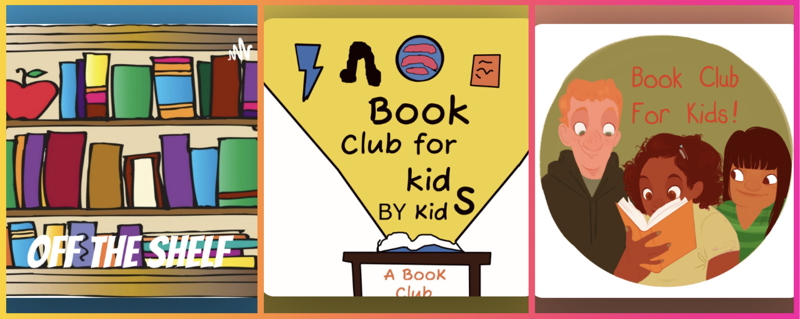

After listening to all the examples, we compiled a list of the important components that we would want to include in our Podcast and co-created our Success Criteria with the class. We did not share this document with the students due to the large number of items. Instead we took the ideas and broke the success criteria down into checklists for each section of the podcast planning (e.g, intro; segment 1) which we will discuss further in the next section.
Step 3 Planning the Podcast
We knew this project needed to be scaffolded carefully in order for all students to be successful. We created a template in Book Creator that would support students’ research and planning. We were able to embed links to videos we wanted them to watch right in the template. Students watched videos of the authors reading their books (available through the Forest of Reading program), as well as any interviews they had done.
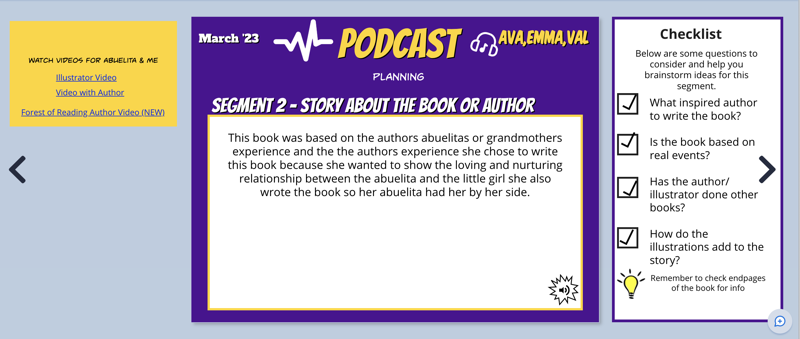
The students were all able to work in one book collaboratively with Book Creator’s real-time collaboration feature and both teachers were able to access and give feedback. Please see the plus (+) symbol in the bottom right corner of the image below. Some students put point form notes, while others started writing out their script.
The students’ podcast planning book was broken down into different sections which would follow the segments in their podcast. You can read a sample planning book here. We broke our success criteria up, including only the relevant criteria to that section. We had it on the side of each page. Students could move the checkmarks as they completed them. When you are in edit mode of Book Creator, you can use the sides of the pages as we did below. You will not see the information on the sides when you are in read mode. We have never used checklists in Book Creator before, but they worked great!
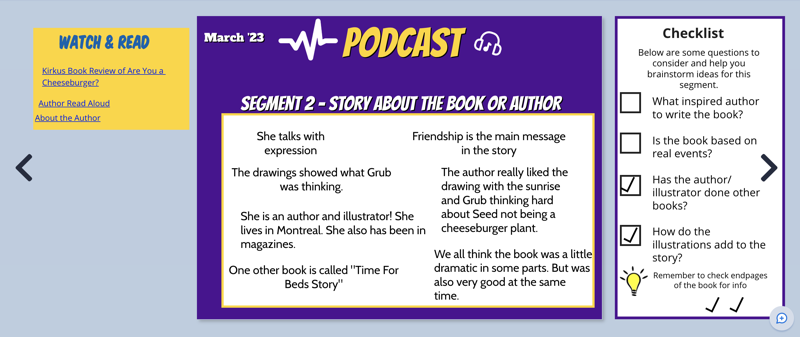
We also found this was an effective way for students to compile information for their podcast all in one place and work collaboratively. While we were researching podcasts, we found that many ended with a “call to action.” This fit in perfectly with our goal of having students vote for their favourite Blue Spruce nominated book. We also wanted to incorporate some media literacy into the project so we gave them the option to include a sponsor ad for their podcast.
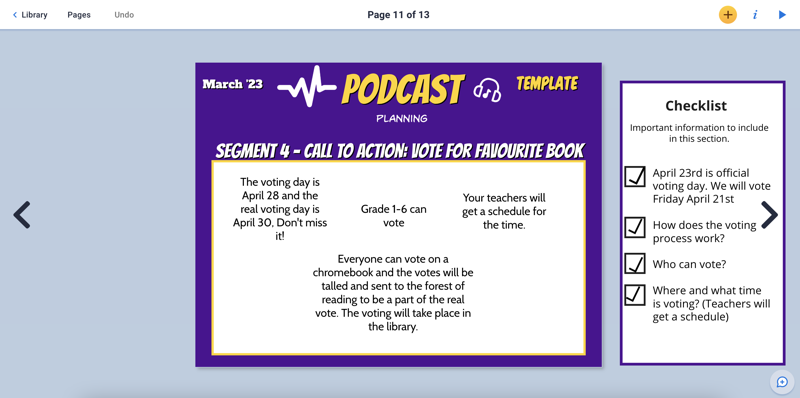
Below is the breakdown of all the different sections included in the planning book:
Learning Goals (co-created as a class)
Ideas for the Name of our Podcast (copy of our class brainstorming page with all the options)
Introduction
Segment 1 – Excerpt from the Book
Segment 2 – Story behind the book/author
Segment 3 – Questions for the podcast (that group members would answer)
Segment 4 – Call to Action
Conclusion
Extra Credit: Sponsor Ad
During the planning stage of the project, we reached out to the authors of each book. We didn’t know if it would be possible, but hoped that they might answer our students’ questions. We were thrilled when all 4 authors and even one illustrator, instantly agreed to record their responses and send us the audio files so that we could include them in the podcast. Some even went above and beyond and recorded an intro and a thank-you message to use. It was beyond our wildest dreams! We couldn’t wait to share the news with our students. We then added an extra segment into each book where they would put the questions for the author & Illustrator. We used the same page to insert the author’s responses as they came in so that the groups could listen to the audio recordings.

We noticed in this part of the project that several students took advantage of the option to record their ideas in Book Creator (see image below). Digital tools like Book Creator remove barriers that may exist, allowing students to fully demonstrate their knowledge and share ideas. One student who struggles with getting his ideas down on paper, chose to share all his ideas by recording his voice directly in Book Creator. Other groups recorded excerpts they would read on their podcast. Ultimately we are interested in their ideas, so it is efficient to capture them without getting stuck on spelling.
Script Writing
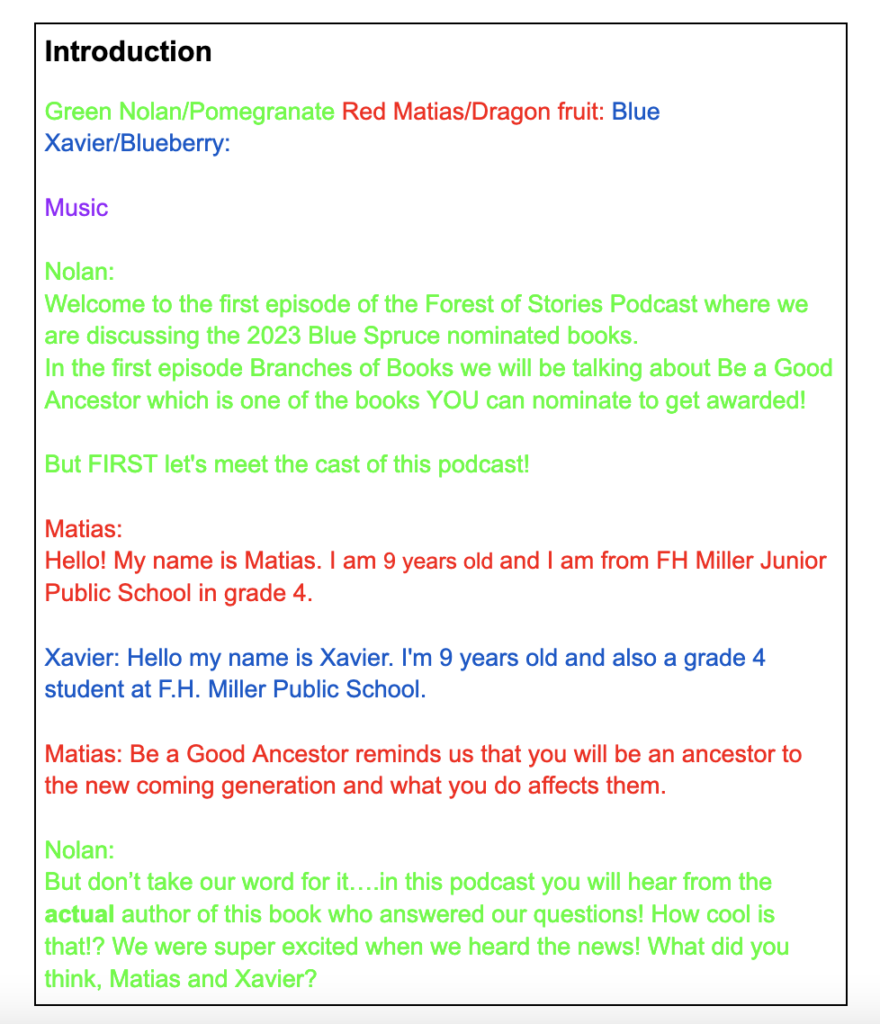
This was a new writing format for some of our students. We found some examples by other students online that we shared with them to help them get started. We created a graphic organizer with the different segments to support their writing. Some used speech to text, while others wrote on paper first and then typed into the script.
Instinctively, they all colour coded their lines to make it easier during recording. The groups were fairly independent during this portion of the project. We gave feedback as needed and some revisions were made. Overall, we were quite impressed with how they understood the conversation format of the podcast. Listening to many examples at the start of the project clearly paid off!


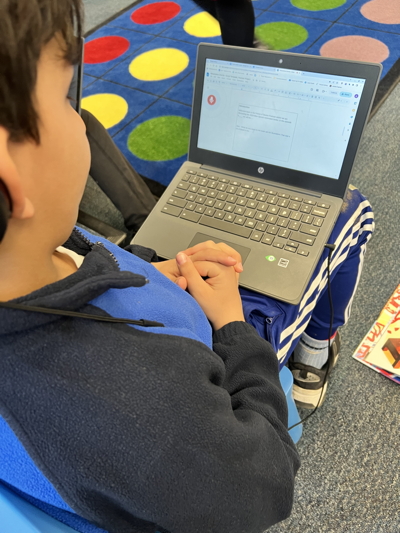
Rehearsing the Podcast
Students had a period to practise their scripts while they were waiting for their turn to record. Some students even did extra practice at home (specifically those who require repetition before their reading becomes fluent). Providing that extra time relieved the anxiety for many of our students. When we co-created the success criteria with the students, they noted that there should be rehearsal time so that it sounds fluent and not choppy. One student said you should engage your audience with a friendly voice that has lots of expression, like you are “dancing with your voice.”
Recording the Podcast
Through our school board, all students have access to the web version of WeVideo. We had never used the program before so we all learned together. There are great videos from WeVideo Academy online. We used the Classroom version of WeVideo (instead of the Classic) so that we could create an assignment and have all the group members join the same project and work collaboratively. It also saves automatically which students are used to from the Google Workplace
We bought a mini podcast microphone for this project which plugged right into our Chromebooks using the USB port and worked without needing to download anything. There was a big difference in sound quality. I would highly recommend using one. It filtered out the background noise. You could even take an additional step and put the Chromebook and microphone in a portable recording booth. We had one gifted to us by a former art teacher at the school who made it with students. It works really well. We wanted to capture the students as they were recording so we didn’t use a sound box on this project. However, they are easy to make if you don’t have one.
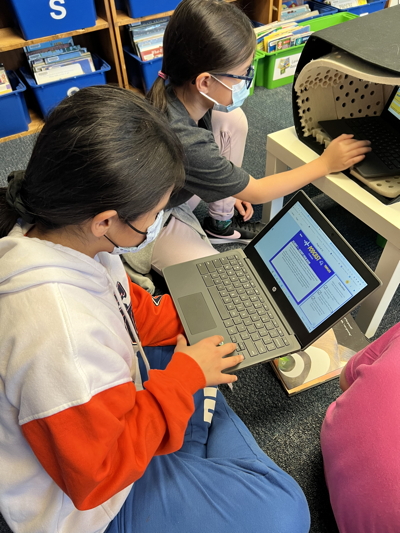
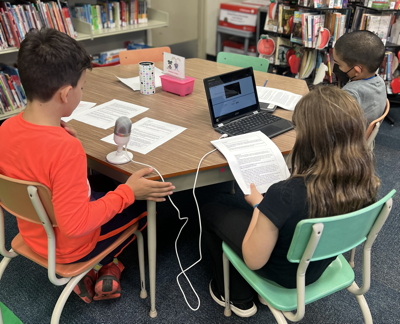
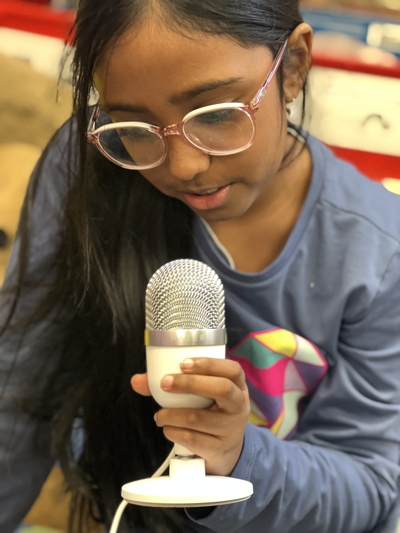
Teacher tips: Sound Tiles / DIY Sound Box
Considerations
We found that WeVideo is not as intuitive as iMovie and we needed to watch some tutorials to figure out some features. We also encountered some issues while using the program. At times the media was slow to import and we had difficulty saving one project file, although it eventually saved. One project file mysteriously disappeared and we had to redo it. These do not seem to be common issues. Overall, we would use the program again for many of the features outlined below.
Editing Podcast with WeVideo
Below is a screenshot of the teacher dashboard. you can see the status of student projects (e.g., who has turned in and who is still working). You are also able to go into all the projects and leave feedback, which we discuss below.
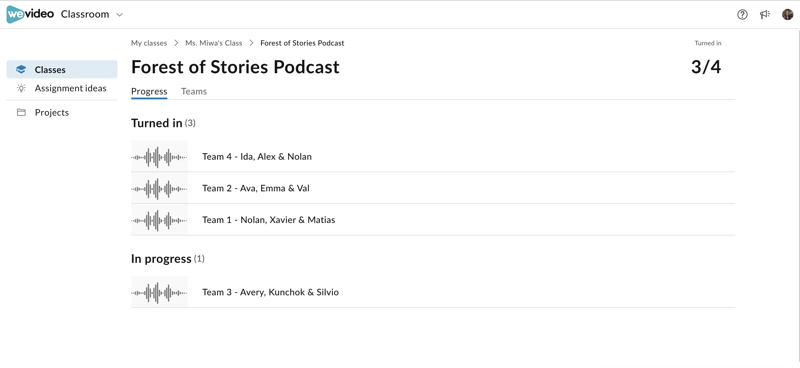
Project file for a group: When you are in the project file, you can see who is collaborating on the project, all the media and the timeline below where you put your podcast together. You can preview the project as you are editing. For more information, we recommend watching the videos on WeVideo Academy.
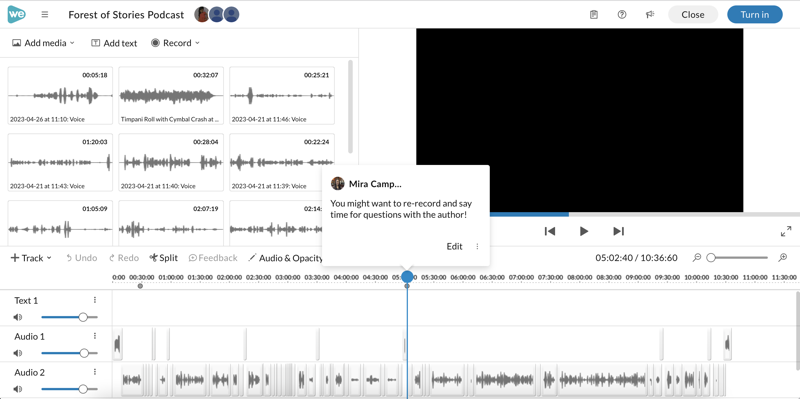
What we loved about using WeVideo was that we could record directly into the project file. Our microphone just plugged into the Chromebooks and was ready to go. Another advantage is there is an Essentials Library of royalty-free stock music built into the program that students can choose from and no attribution is required. Furthermore, the students didn’t get sidetracked searching too long for music. They were able to quickly pick a clip to use in their project. It imports directly into the project file which is convenient.

TIP: WeVideo Podcast Instructions
Feedback
Another great feature of the classroom version is the ability to leave feedback. You can select the exact place in the timeline where you want to leave a comment. We do wish the feedback icon was larger. One thing to also consider is that if you leave a comment and then clips get shifted around, it wouldn’t be in the correct place.

Once the groups turn in their project, they are given the option to download it and save it to the computer or Google Drive. Teachers also have this option. That MP3 file is what we used to share the podcast.
Authentic Audience: Sharing with Authors
One aspect that made this project so successful was the students knew they had an authentic audience beyond the school. Even more unbelievable was the fact that the authors of the books not only were guests on their podcast, but also listened to their podcasts and sent messages to each group. This is a key part of all our projects. Students are motivated to do their best work when it is being shared. We also instil in them that they will need to work hard and produce their best work. We have high expectations for all students and make sure that they are ALL successful through careful planning using the Universal Design for Learning Framework. With high standards and meticulous work, the students also get a great sense of accomplishment.
Unexpectedly the authors thanked us for the experience and all really loved being part of the podcast. We were truly grateful that they donated their time and made a real impact on our students.
School Leadership: Voting Day
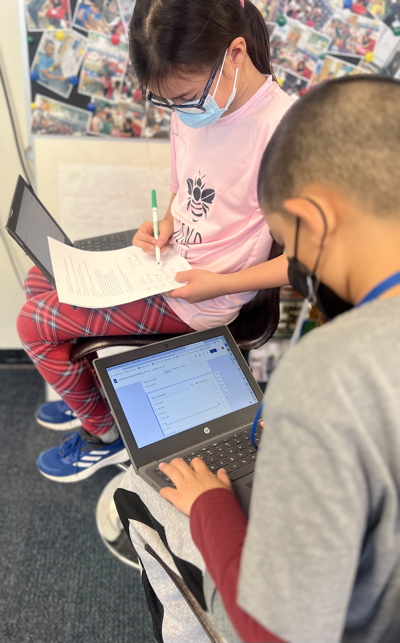
for voting
Once the podcasts were completed, we shared them with the entire school. The intent of it was to promote the Blue Spruce nominated books ahead of the school-wide vote for the favourite.
Two of the Grade 4 students in the class created a Google Form with photos of the books. Classes from K-6 came to the library at scheduled times to vote. Involving the whole school was great at building excitement and also provided a leadership opportunity for our Grade 4 class.
Our students demonstrated incredible leadership interacting with all the classes and running the voting process which was incredibly smooth and efficient.
In addition to voting, the classes also had an opportunity to ask the Grade 4s about making a podcast and they discussed their favourite books. During the discussion with the Grade 5/6 class, there were some meaningful moments.
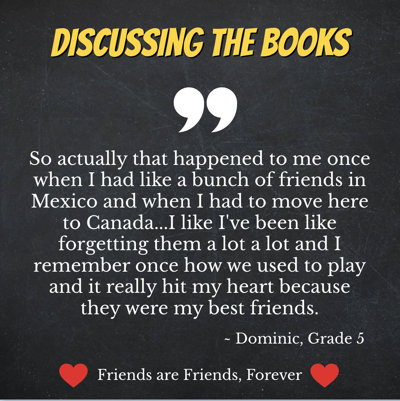
One of our Grade 5 students Dominic, who had moved from Mexico made an emotional connection to a book and shared his experience. While Ida, one of our Grade 4 students led the discussion and shared her own personal experience as it related to the book.
Other students found the books relatable and mirrored issues that are currently going on in the world. “The reason I chose Abuelita & Me is because it’s relatable in many ways and it also matches some of the real problems in the world like stereotypes.” ~ Deshawn, Grade 5
You can watch the highlights from the Voting Day in this reel
Parent Engagement
What I love about Book Creator is how easily we can share the projects that we do with our parent community and other educators. I often use it as a chance to document the project in addition to sharing the student work. You can publish books and then share the link. We email to our parents and also share on social media. I created an Instagram account for the library (m.campbell.library) and it has been a great way to engage our parent community.
If you have used Book Creator before, a podcast might not be the first thing you think of. We had never tried this before, but it actually worked really well. In Book Creator, you can upload audio clips (there is no maximum length) and then make the icon invisible. We designed our podcast page to look like Spotify and then hid the audio in the play button so when readers click on it, the podcast plays! You can read Book Creator books on any device, even a phone. I was even able to listen to the podcast on the drive home.
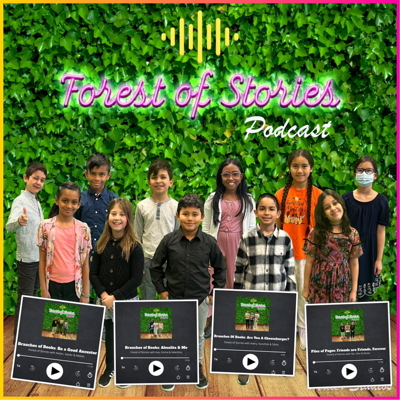
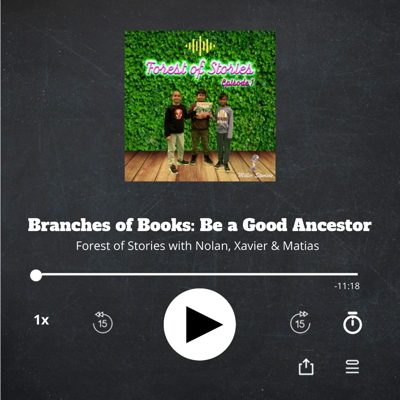
Our parents often tell us how much they enjoy seeing their children in their school environment. It’s like a window into the classroom. We have included some quotes from our parent community where they share their perspective on this project.
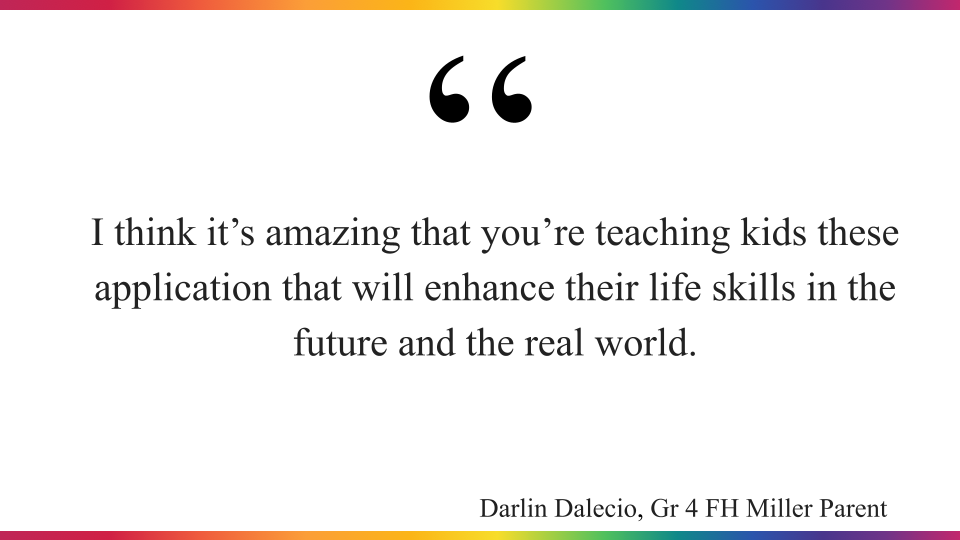
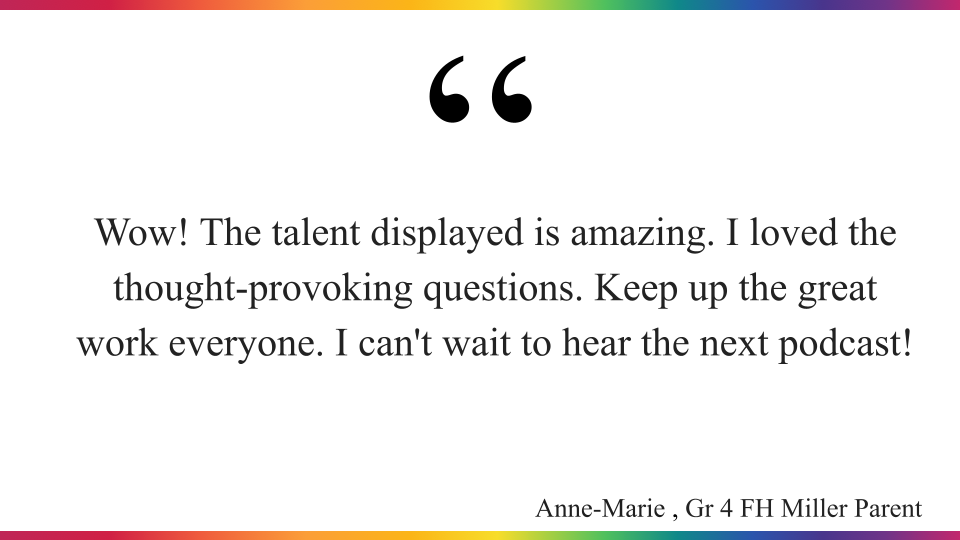

What’s Next? Our Celebration
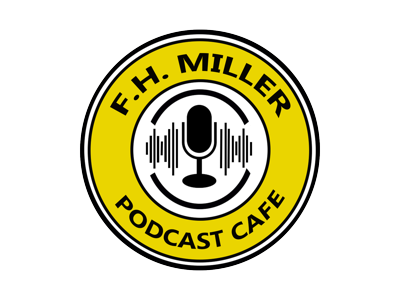
We have previously done a modern book tasting in the Library as a way to engage students and expose them to a variety of different genres. We wanted to update this event, so we created the Miller Podcast Café. When students come to the café, they will be able to choose which of the four different podcast episodes they want to listen to and they will provide feedback to their peers through a Book Creator book.
It will also give them a chance to look through the Book Creator digital book we created about this project which has many behind the scenes photos and videos. There will be a scheduled time for all classes (Grade 1-6) to come visit the café. In the same visit, we will also be showing the Blue Spruce awards ceremony where students will find out which nominated book won.
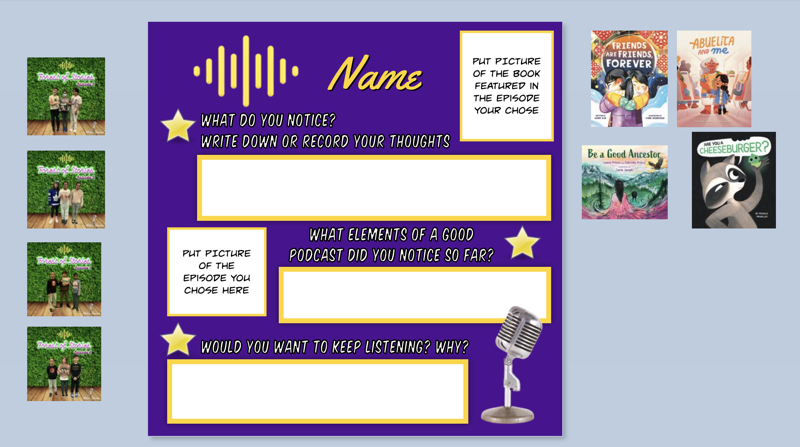
If you would like to be part of the journey and see how this celebration turns out, please follow the FH Miller Library instagram (m.campbell.library) on Instagram.
Collaboration in the Library Learning Commons
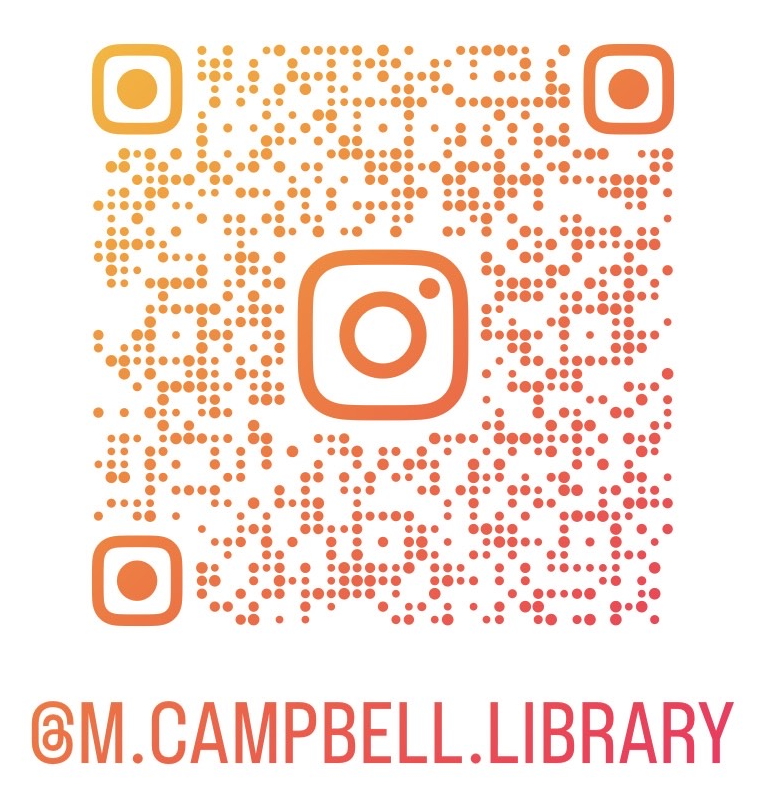
As a teacher-librarian, it can be challenging to create meaningful learning experiences in short library periods. In addition, while I know all the students in the school, building a relationship can be more challenging as I spend less time each week with students. The classroom community created by the teacher helps bridge the gap because students are more willing to participate in activities in the library.
This project exceeded our expectations and turned out better than we could have hoped for. We believe this is due to the careful planning of the project keeping the UDL framework in mind. The planning stage took a long time, but investment paid off with the professional podcasts students made. The format of a podcast amplified student voices that we do not typically hear from. Initially, we had hoped for each group to make two episodes, but we did not have enough time.
In addition, involving the whole school in the Voting Day built excitement and made the project more meaningful. We did not anticipate the emotional responses and deep connections several students made to the nominated books. It went well beyond what a traditional Read Aloud and discussion might elicit as it was their peers leading the discussions. As a result, the whole school was invested in the outcome of the final Blue Spruce winner! It also created more leadership opportunities for the Grade 4 class than initially planned.
From a Teacher-Librarian’s Point of View:
I really respect and admire the classroom community that Nori has created. They are an empathetic group of future leaders. She weaves important discussions into their classroom routine on a daily basis including topics of social justice, Indigenous perspectives, environmental issues, stereotypes, racism and more. As a result, they had a lot of prior knowledge which they could apply to this project. The success of this project is directly due to our collaboration as colleagues.
From a Classroom Teacher’s Point of View:
Working with Mira has truly been an amazing experience for both myself and the students. She has so many great ideas that help to inspire many of our projects together and it helps to be able to work together on them, since we are able to get so much more done and make them bigger and better than even we imagine. I have learned so much from her, especially her knowledge of technology that has helped me become a better teacher in this area. The success of colleagues working together is shown in this project.
We hope you learn from our experience and embark on a collaborative journey of your own. Consider what can be achieved beyond the curriculum and traditional classroom lessons.
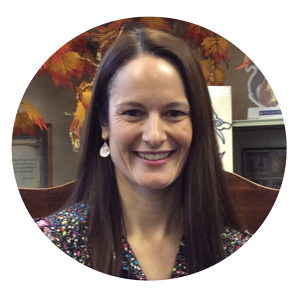
Mira Campbell has 17 years of experience as a Teacher-Librarian and Special Education Teacher. She is a Digital Lead Learner Mentor with the Toronto District School Board (TDSB) and a Book Creator Ambassador. She enjoys collaborating with teachers during Library Partnership projects and loves to celebrate students’ hard work with big reveals!

Nori Miwa is a Junior Teacher at F. H. Miller. She has been teaching in the TDSB for 11 years and at Miller for 4. She enjoys creating a classroom community where students’ voices are heard and their interests celebrated. She believes in social justice and the importance of extracurricular activities. She is often seen happily coaching throughout the year!